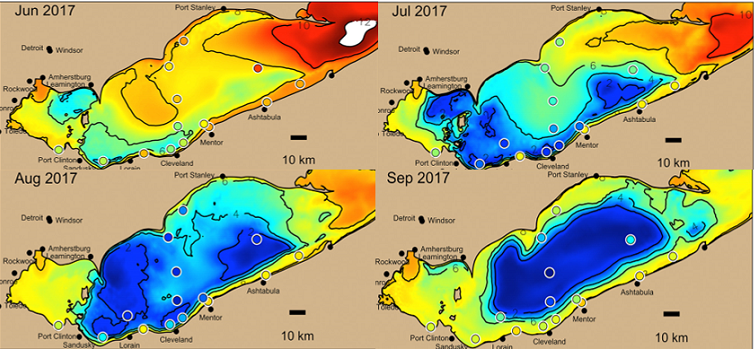We Can’t Direct the Wind, but We Can Adjust the Sails: Using Models to Predict Hypoxia in Lake Erie
By Michael Lim
4 February 2020

It’s common knowledge that climate change is causing an increase in the average temperature around the world, as well as the frequency of extreme weather events. What may be less well known, however, is that the combination of rising temperatures and agricultural activities are also leading to a harmful reduction in the level of dissolved oxygen in some water bodies, a phenomenon known as hypoxia.
Hypoxia can be deadly to aquatic organisms at sufficiently low oxygen levels or over long periods of time, while sublethal effects include reduced growth and migration away from hypoxic waters. Where and how often hypoxia occurs depends on several factors such as the size of the water body, the number of organisms present, and the temperature of the water and surrounding air. Hypoxia can potentially occur in any water body, but it has become particularly worrisome in Lake Erie.
Prof. Josef Ackerman from the Department of Integrative Biology has a deep interest in bottom-dwelling aquatic organisms and has been studying lake dynamics for nearly 30 years. He recently teamed up with Dr. Mark Rowe from the National Oceanic and Atmospheric Administration (NOAA) to get a better understanding of the factors that contribute to hypoxic events in Lake Erie.
“My first foray into working with Lake Erie was while studying zebra mussels in the mid-90s,” say Ackerman. “At the time, we were focused on how zebra mussels could access resources from different areas of the lake, but then we came across the broader issue of hypoxia.”
Lake Erie may be the smallest of the Laurentian Great Lakes by volume, but it is the most biologically productive. This is due partly to nutrient runoff from farms, which leads to algal blooms. When the algae die, they settle on the bottom of the lake and decompose, consuming oxygen in the process. This creates layers in the lake, with the coldest and most hypoxic water at the bottom, and the warmest and most well oxygenated water near the surface. But because Lake Erie is large and relatively shallow, these layers are subject to frequent upwelling following strong winds, bringing hypoxic water nearer to the surface.
These hypoxic episodes directly affect not only aquatic species in the affected areas, but humans as well, reducing the quality and taste of drinking water taken from the lake.
Interestingly, it wasn’t until Ackerman and post-doc Dr. Aidin Jabbari attended a conference on Great Lakes research that they became aware that Lake Erie hypoxia via upwelling was a shared interest across disciplines, attracting physicists and mathematicians as well as biologists. Rowe, a modeling expert who works for the NOAA Great Lakes Environmental Research laboratory in Ann Arbor, Michigan, invited Ackerman and Jabbari to join their team.

“All people, not just researchers, tend to think in isolation,” says Ackerman. “So when you’re inspired to learn about something, and then find out there are several like-minded groups out there all searching and trying to understand the same thing…it is really kind of cool.”
Rowe and colleagues aimed to identify what combination of physical characteristics (such as air temperature, wind speed and direction, and cloud cover) were most often associated with hypoxic conditions. Their goal was to create a computational model that could predict the occurrence of future hypoxic events based on a specific set of environmental conditions.
To develop their model, the team used several years of meteorological data collected from weather stations all over the lake, alongside historical records of hypoxia events in different areas of the lake including those in Canadian waters. After identifying which physical factors appeared to be most closely associated with hypoxic events, the researchers then tested their model against a set of sensors placed throughout the lake which measured temperature, wind, and oxygen levels across both space and time.
The model and field data revealed that temperature and wind direction are critical in creating hypoxic conditions. In particular, hypoxia is strongest during the summer months, and strong winds can trigger earlier periods of hypoxia on their respective shores. For example, a southwesterly wind results in earlier hypoxia on the southern shores of Lake Erie, while northeasterly winds reverse the pattern and can lead to upwelling of hypoxic water along the south shore near drinking water intakes.

Although the team did not include biological factors such oxygen consumption by aquatic organisms, the model’s accuracy hints at the unexpectedly large role that environmental conditions may play in hypoxia patterns in Lake Erie.
While little can be done to alter the weather, many will benefit from knowing when and where hypoxia is likely to occur. For example, drinking water treatment plants need to know when to reduce water intake, while biologists need to know which areas to avoid sampling from when trying to estimate aquatic populations. The model also helps pinpoint areas which may see repeated episodes of hypoxia, including near the shores of Ohio, the Bass Islands, and northern Pelee Island, particularly as climate change progresses and the weather becomes more variable.
For now, it’s important that environmental protection agencies from both countries monitor oxygen levels across Lake Erie more frequently. This will provide additional data that can help refine the model into the future, and help better protect the lake for generations to come.
“We’ve learned a lot from studying Lake Erie, and hope that people will learn and build upon what we’ve learned,” says Ackerman. “If you understand how different processes in the environment work, then it becomes incredibly valuable when something impacts the environment in a negative way. Only by understanding how all the different processes involved work and affect each other, can you then know how to bring positive change.”
Other major collaborators for this research include E.J. Anderson and C.A. Stow (NOAA), D. Beletsky (Cooperative Institute for Great Lakes Research), S.D. Moegling (Cleveland Water), J.D Chaffin (Ohio State University), J.C. May (U.S. EPA), and P.D. Collingsworth (Purdue University). Funding for this research was provided by the NOAA.
Read the full article in the Journal of Geophysical Research: Oceans.
Read about other CBS Research Highlights.